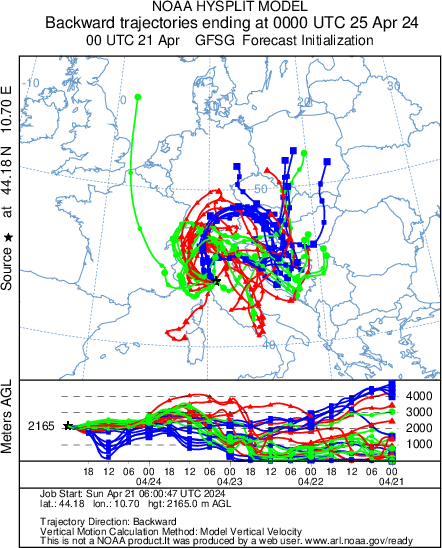Greenhouse gases
The Sun powers Earth’s climate, radiating energy at very short wavelengths, predominately in the visible or near-visible (e.g., ultraviolet). About one-third of the solar energy reaching the top of Earth’s atmosphere is reflected back to space. The remaining two-thirds is absorbed by the surface and, to a lesser extent, by the atmosphere. To balance the absorbed incoming energy, the Earth must, on average, radiate the same amount of energy back to space. The Earth radiates primarily in the infrared part of the spectrum.
A large amount of the radiation emitted by Earth's surface is absorbed by the atmosphere, including clouds, and it is radiated back to Earth. This is the so-called greenhouse effect. The two most abundant gases in the atmosphere, nitrogen (78% of the dry atmosphere) and oxygen (21%), play almost no greenhouse effect. Water vapour is the most important “natural” greenhouse gas, and carbon dioxide (CO2) is the second-most important one. However, CO2 is the most important greenhouse gas which atmospheric concentrations are directly affected by human activities. On the other hand, human emissions play little direct influence on water vapour. Methane, nitrous oxide, tropospheric ozone and halogens (CFC, HFC, PFC, SF6) are present in the atmosphere at "trace levels" (from ppt to ppm levels) but greatly contribute to the greenhouse effect. Some of these molecules (CH4, tropospheric ozone and halogens) can be also considered Short-Lived Climate Forcers (like tropospheric ozone and black carbon).
As stated by the last IPCC report (AR5), “Warming of the climate system is unequivocal, and since the 1950s, many of the observed changes are unprecedented over decades to millennia. The atmosphere and ocean have warmed, the amounts of snow and ice have diminished, sea level has risen, and the concentrations of greenhouse gases have increased”. Moreover, “Human influence on the climate system is clear. This is evident from the increasing greenhouse gas concentrations in the atmosphere, positive radiative forcing, observed warming, and understanding of the climate system”.
Time series of 6 halogenated gases at Mt. Cimone. Black dots: baseline data; red dots: elevation above the baseline; and green lines: best fit of the monthly means of baseline data
In the framework of the Global Atmosphere Watch (GAW) programme of the World Meteorological Organization (WMO), thanks to the collaboration between CNR-ISAC and Urbino University, systematic and reliable long-term observations of greenhouse gases are carried out at ICO-OV: methane (CH4, since 2008), nitrous oxide (N2O, since 2008), and halogens(CFCs, HFCs, SF6, since 2002). Carbon dioxide (CO2) measurements are also carried out at Mt. Cimone by the Italian Air Force at its own Meteorological Observatory (since1979). These long-term observations programmes allowed to evaluate both long-term variability as well as to investigate the source (especially over the European domain) of these important atmospheric compounds.
Average retrieved CH4 emission strengths over Europe for the period May–Dec 2010 by using data from Mt. Cimone and other 8 stations in Europe. More details can be found in Weaver et al., 2014.
Selected references Cristofanelli P, Scheel H-E, Steinbacher M, Saliba M. 2014. Long-term surface ozone variability at Mt. Cimone WMO/GAW global station (2165 m a.s.l., Italy), Atmospheric Environ., 101:23-33. Weaver C, Kiemle C, Kawa SR, Aalto T, Necki J, Steinbacher M, Arduini J, Apadula F, Berkhout H, Hatakka J et al.. 2013. Retrieval of methane source strengths in Europe using a simple modeling approach to assess the potential of space-borne lidar observations, Atmos. Chem. Phys. Discuss. 13. Maione M, Giostra U, Arduini J, Furlani F, Graziosi F, Lo Vullo E, Bonasoni P. 2013. Ten years of continuous observations of stratospheric ozone depleting gases at Monte Cimone (Italy) - comments on the effectiveness of the Montreal Protocol from a regional perspective, Sci. Total. Environ., 155(64). Giostra U, Furlani F, Arduini J, Cava D, Manning AJ, O'Doherty SJ, Reimann S, Maione M. 2011. The determination of a regional atmospheric background mixing ratio for anthropogenic greenhouse gases: a comparison of two independent methods, Atmos. Environ., 45. Keller CA, Hill M, M. K. Vollmer, Henne S, Brunner D, Reimann S, O’Doherty S, Arduini J, Maione M, Ferenczi Z et al.. 2011. European Emissions of Halogenated Greenhouse Gases Inferred from Atmospheric Measurements, Environ. Sci and Technol, 46(1):217-225. Cristofanelli P, Bonasoni P. 2008. Background ozone in the southern Europe and Mediterranean area: influence of the transport processes, Environ. Poll., 157(5):1399-406.




